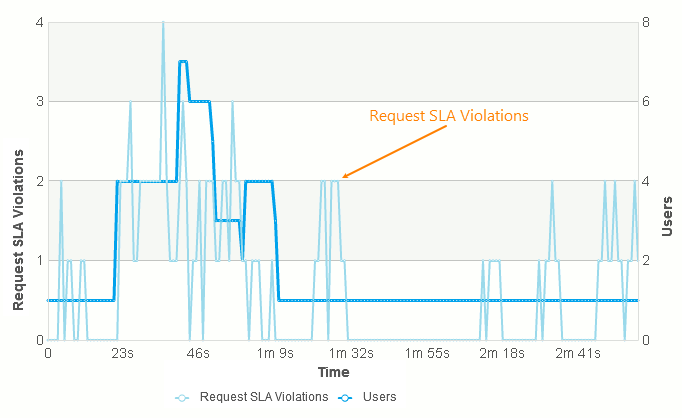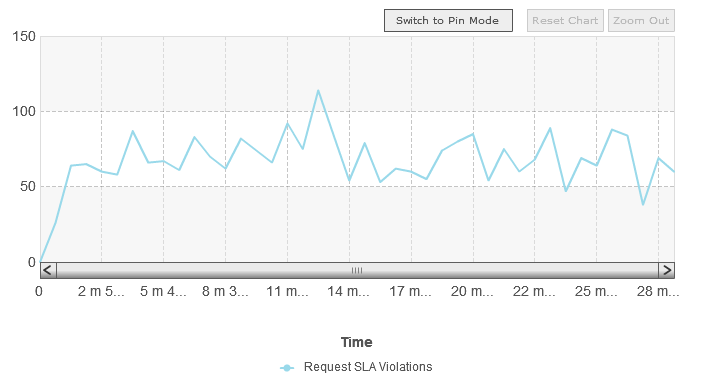The Request SLA Violations graph of the Report panel shows the relation between the number of virtual users, the number of times the SLA criterion was violated for HTTP requests and WebSocket messages, and the test run time. In other words, it shows how many users were simulated and how many violations occurred at any given moment of the test run due to exceeding the SLA threshold.
 In earlier LoadComplete versions, the Quality of Service: Response Errors graph was used, which was replaced with the Request SLA Violations graph in LoadComplete version 4.96. If you open a project created in an earlier version of LoadComplete, the Quality of Service: Response Errors graph will be transformed into the Request SLA Violations graph automatically. However, the graph data may be shown incorrectly.
In earlier LoadComplete versions, the Quality of Service: Response Errors graph was used, which was replaced with the Request SLA Violations graph in LoadComplete version 4.96. If you open a project created in an earlier version of LoadComplete, the Quality of Service: Response Errors graph will be transformed into the Request SLA Violations graph automatically. However, the graph data may be shown incorrectly.
Viewing the Graph
-
Open the desired Report item (if it is not open yet). To do that, expand the test log item node under the Project_Name Logs folder in the Project Explorer and double-click its child Report node.
-
In the Report panel, select the Pass / Fail tabbed page.
-
Expand the Request SLA Violations section.
Requirements
-
To view the graphs and charts shown in the Report panel, install Flash Player 8 or later for Windows Internet Explorer on your computer. You can download the latest version of the player from the Adobe web site:
-
To display the graph, it is also required that you specify either the Max Time to First Byte value for the entire test, or the SLA value for individual requests and WebSocket messages of your scenarios. Otherwise, the graph will not be shown. For more information, see Viewing the SLA Graphs.
Note: The Max Time to First Byte threshold value you specify for the entire test will be applied both to HTTP requests and to WebSocket messages.
Pages
The Request SLA Violations section contains several tabbed pages that show violation statistics in different modes.
With Virtual Users Page
The graph on this tab shows how the number of violations and the number of virtual users change during the test run.

The thin line, Max. Request SLA Violations, represents the maximum number of violations at any moment of the test run.
The thick line, Request SLA Violations, represents the average number of violations at any moment of the test run.
If the average and maximum values are equal, the graph shows only the average values.
You can show and hide individual graph lines by clicking the line name in the graph legend.
| Note: | You can view the number of violations that occurred because the SLA criterion was exceeded on the Runtime > Graphs page during the test run. |
To see the exact value of a metric at a specific moment, hover the mouse pointer over the needed data point on the graph: a tooltip showing the metric value will appear.
Printing the Contents of the Report Panel
Note that LoadComplete shows the data shown in the graph in the tabular format. An appropriate table is shown under the Request SLA Violations graph when you start printing the contents of the Report panel, that is, when you click Print on the panel's toolbar.
The above-mentioned table contains the following columns:
| Column | Description |
|---|---|
|
Time |
Contains time values from 0 to the test execution time in increments of one second. |
|
Request SLA Violations |
Contains the number of violations that occurred because the SLA criterion value was exceeded at the specified moment. |
|
Users |
Contains the number of virtual users that were simulated at the specified moment. |
More Information
For more information on working with the graphs and charts shown in the Report panel, see Viewing the Report Charts and Graphs.
Scroll Chart Page
This page contains a graph that represents the number of SLA value violations at any moment of the test run. A sample view of the graph is as follows:

The graph shows only the exact number of violations (these values are shown on the Runtime > Graphs page of the project at runtime).
You can zoom this graph in and out. You can also select the desired area of the graph and then overlay it with another area. For more information on working with scroll graphs, see Working With Scroll Graphs.
Chart by Region Page
This page shows graphs organized by Amazon cloud regions.
The graphs show the number of virtual users and the number of SLA value violations for HTTP requests and WebSocket messages in each region at any moment of the test run. The thick line shows the average number of violations in regions, the thin line shows the maximum number of violations. If the average and maximum values are equal, the graph shows only the average values.
 |
This page is available only when you run tests both on a cloud computer and on a local workstation, or on cloud computers that belong to a different region. |
You work with these graphs in the same way you work with the graphs on the With Virtual Users tabbed page. For more information, see the section above.
Data Table Page
This page contains a table that represents the data of the graphs displayed on the With Virtual Users page. For a detailed description of its columns, refer to the description of the graphs.
 |
This tab is not visible in LoadComplete. To view its contents, export your test results to an external file. |
See Also
Viewing the SLA Graphs
About Test Results
Typical Response Codes
Resolving Errors and Warnings
Test Result Panels
Creating and Configuring Load Tests

